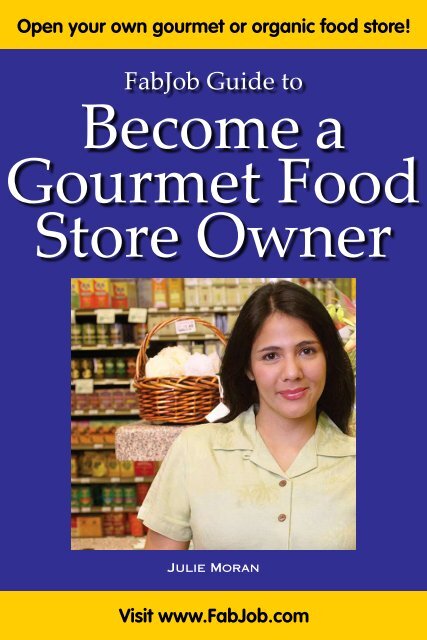Become a Gourmet Food Store Owner - Fabjob.com
Become a Gourmet Food Store Owner - Fabjob.com
Become a Gourmet Food Store Owner - Fabjob.com
Create successful ePaper yourself
Turn your PDF publications into a flip-book with our unique Google optimized e-Paper software.
Open your own gourmet or organic food store!<br />
FabJob Guide to<br />
<strong>Be<strong>com</strong>e</strong> a<br />
<strong>Gourmet</strong> <strong>Food</strong><br />
<strong>Store</strong> <strong>Owner</strong><br />
Julie Moran<br />
Visit www.FabJob.<strong>com</strong>
FabJob Guide to <strong>Be<strong>com</strong>e</strong> a <strong>Gourmet</strong> <strong>Food</strong> <strong>Store</strong> <strong>Owner</strong><br />
Contents<br />
About the Author .........................................................................................8<br />
1. Introduction ..........................................................................................10<br />
1.1 A Growth Industry .......................................................................11<br />
1.2 Owning a <strong>Gourmet</strong> <strong>Food</strong> Business ............................................13<br />
1.3 Benefits of Being a <strong>Gourmet</strong> <strong>Food</strong> <strong>Store</strong> <strong>Owner</strong> ......................17<br />
1.4 Inside This Guide .........................................................................20<br />
2. Getting Ready ......................................................................................21<br />
2.1 Skills and Knowledge You Will Need .......................................21<br />
2.1.1 Are You a “<strong>Food</strong>ie”? ...........................................................22<br />
2.1.2 People Skills .........................................................................23<br />
2.1.3 Retail Management Skills ..................................................26<br />
2.1.4 Business Skills .....................................................................28<br />
2.2 Gaining Valuable Experience ......................................................31<br />
2.2.1 Work in a <strong>Gourmet</strong> <strong>Food</strong> <strong>Store</strong> .........................................31<br />
2.2.2 Talk to <strong>Gourmet</strong> <strong>Food</strong> <strong>Store</strong> <strong>Owner</strong>s ...............................33<br />
2.2.3 Join an Association .............................................................35<br />
2.2.4 Online Communities ..........................................................38<br />
2.2.5 Business Organizations ......................................................39<br />
2.3 Be Your Own “Mystery Shopper” .............................................39<br />
2.4 Educational Programs .................................................................44<br />
2.4.1 Business Courses ................................................................44<br />
2.4.2 Culinary Courses ................................................................50<br />
2.5 Resources for Self-Study ..............................................................51<br />
2.5.1 Trade Shows ........................................................................51<br />
2.5.2 Websites ...............................................................................52<br />
2.5.3 Magazines ............................................................................53<br />
2.5.4 Books ....................................................................................54<br />
Copyright © 2008 FabJob Inc. • www.fabjob.<strong>com</strong> • 4
FabJob Guide to <strong>Be<strong>com</strong>e</strong> a <strong>Gourmet</strong> <strong>Food</strong> <strong>Store</strong> <strong>Owner</strong><br />
3. Starting Your <strong>Gourmet</strong> <strong>Food</strong> <strong>Store</strong> ..................................................55<br />
3.1 Choosing Your Niche ...................................................................56<br />
3.1.1 <strong>Gourmet</strong> “Generalist” <strong>Food</strong> <strong>Store</strong>s ..................................57<br />
3.1.2 Discount <strong>Gourmet</strong> <strong>Food</strong> <strong>Store</strong>s ........................................58<br />
3.1.3 Organic and Natural <strong>Gourmet</strong> <strong>Food</strong> <strong>Store</strong> .....................58<br />
3.1.4 Specialty <strong>Gourmet</strong> <strong>Food</strong> <strong>Store</strong> .........................................58<br />
3.1.5 Fresh <strong>Gourmet</strong> Meal Preparation <strong>Store</strong>s .........................59<br />
3.2 Options for Starting a <strong>Gourmet</strong> <strong>Food</strong> <strong>Store</strong> ..............................59<br />
3.2.1 Buying an Established <strong>Store</strong>..............................................59<br />
3.2.2 Franchising ..........................................................................66<br />
3.2.3 Opening a New <strong>Gourmet</strong> <strong>Food</strong> <strong>Store</strong> ..............................74<br />
3.3 Choosing a <strong>Store</strong> Name ...............................................................75<br />
3.4 Your Business Plan .......................................................................77<br />
3.4.1 What To Include In a Business Plan .................................78<br />
3.4.2 Start-Up Financial Planning ..............................................84<br />
3.4.3 A Sample Business Plan .....................................................93<br />
3.4.4 Business Plan Resources ..................................................110<br />
3.5 Start-Up Financing .....................................................................110<br />
3.5.1 Getting Prepared ...............................................................111<br />
3.5.2 Equity vs. Debt Financing ...............................................112<br />
3.5.3 Borrowing Money .............................................................114<br />
3.5.4 Finding Investors ..............................................................116<br />
3.5.5 Government Programs ....................................................119<br />
3.6 Legal Matters .............................................................................120<br />
3.6.1 Your Business Legal Structure ........................................120<br />
3.6.2 Business Licenses ..............................................................126<br />
3.6.3 Taxes ...................................................................................128<br />
3.6.4 Insurance ............................................................................131<br />
Copyright © 2008 FabJob Inc. • www.fabjob.<strong>com</strong> • 5
FabJob Guide to <strong>Be<strong>com</strong>e</strong> a <strong>Gourmet</strong> <strong>Food</strong> <strong>Store</strong> <strong>Owner</strong><br />
4. Setting up Your Retail <strong>Store</strong> ............................................................134<br />
4.1 Finding a Location ......................................................................134<br />
4.1.1 Possible Locations .............................................................135<br />
4.1.2 Points to Consider ............................................................140<br />
4.1.3 Signing Your Lease ...........................................................147<br />
4.2 <strong>Store</strong> Design ................................................................................155<br />
4.2.1 Outside the <strong>Store</strong> ..............................................................156<br />
4.2.2 Inside the <strong>Store</strong>..................................................................158<br />
4.2.3 <strong>Store</strong> Security ....................................................................163<br />
4.3 Displaying Merchandise ...........................................................164<br />
4.3.1 Where to Get Display Fixtures .......................................165<br />
4.3.2 Maximizing Sales ..............................................................165<br />
4.3.3 Creating Window Displays .............................................167<br />
4.4 Retail Equipment and Supplies ................................................171<br />
4.4.1 Items You’ll Need .............................................................171<br />
4.4.2 Suppliers ............................................................................177<br />
4.5 Obtaining Your Inventory .........................................................178<br />
4.5.1 Wholesalers .......................................................................179<br />
4.5.2 Prices and Terms ...............................................................181<br />
5. Running Your Business ....................................................................184<br />
5.1 <strong>Store</strong> Operations .........................................................................184<br />
5.1.1 Developing a Procedures Manual ..................................184<br />
5.1.2 Areas of Operations Checklists ......................................186<br />
5.2 Inventory Management .............................................................188<br />
5.2.1 Inventory Software ...........................................................188<br />
5.2.2 Inventory Tags and Labels ..............................................192<br />
5.3 Pricing Merchandise ..................................................................193<br />
5.3.1 Guidelines ..........................................................................193<br />
5.3.2 Retail Pricing Formulas ...................................................194<br />
Copyright © 2008 FabJob Inc. • www.fabjob.<strong>com</strong> • 6
FabJob Guide to <strong>Be<strong>com</strong>e</strong> a <strong>Gourmet</strong> <strong>Food</strong> <strong>Store</strong> <strong>Owner</strong><br />
5.3.3 Profit Margin vs. Percentage Markup............................195<br />
5.3.4 Standard Markups ............................................................198<br />
5.4. Getting Paid ..................................................................................201<br />
5.4.1 Accepting Debit Cards .....................................................202<br />
5.4.2 Accepting Credit Cards ...................................................202<br />
5.4.3 Accepting Payment Online .............................................203<br />
5.4.4 Accepting Checks .............................................................203<br />
5.5 Financial Management ..............................................................204<br />
5.5.1 Bookkeeping ......................................................................204<br />
5.5.2 Financial Statements and Reports ..................................206<br />
5.5.3 Building Wealth ................................................................215<br />
5.6 Employees ...................................................................................218<br />
5.6.1 When to Hire Help ...........................................................218<br />
5.6.2 Recruiting Staff .................................................................220<br />
5.6.3 The Hiring Process ...........................................................223<br />
5.6.4 New Employees ................................................................227<br />
6. Getting and Keeping Customers ....................................................231<br />
6.1 Marketing Your Business ..........................................................231<br />
6.1.1 Advertising ........................................................................232<br />
6.1.2 Free Publicity .....................................................................235<br />
6.1.3 Promotional Tools .............................................................238<br />
6.1.4 Your Website ......................................................................243<br />
6.1.5 Networking .......................................................................245<br />
6.1.7 <strong>Gourmet</strong> Cooking Classes ...............................................253<br />
6.2 Customer Service ........................................................................256<br />
6.2.1 Greeting Customers .........................................................257<br />
6.2.2 Making the Sale .................................................................258<br />
6.2.3 Return/Exchange Policy ...................................................260<br />
6.2.4 Getting Repeat Business ..................................................262<br />
Copyright © 2008 FabJob Inc. • www.fabjob.<strong>com</strong> • 7
FabJob Guide to <strong>Be<strong>com</strong>e</strong> a <strong>Gourmet</strong> <strong>Food</strong> <strong>Store</strong> <strong>Owner</strong><br />
1. Introduction<br />
You’re likely reading this book because you have a passion for fine food<br />
and want to turn that passion into a new and exciting career. Chances<br />
are, you’re an impassioned “foodie” with a great appreciation for and<br />
knowledge of gourmet food. <strong>Food</strong> for you is one of the great pleasures<br />
of life — not just a means of nourishment, but a wondrous part of the<br />
journey.<br />
Your idea of a perfect day in New York City might be to spend it browsing<br />
the fine imported cheeses, meats, spices, and other hard-to-find<br />
items lining the shelves at Dean & DeLuca. Perhaps you prefer the top<br />
quality appetizers, smoked salmon, and other specialties at the 4th generation<br />
Russ & Daughters, or the unique Grecian sweets, baked goods,<br />
body care and other specialties sold at Mastihashop. Maybe you’d rather<br />
take in a professionally guided tour of the Big Apple’s gastronomic<br />
wonders.<br />
Copyright © 2008 FabJob Inc. • www.fabjob.<strong>com</strong> • 10
FabJob Guide to <strong>Be<strong>com</strong>e</strong> a <strong>Gourmet</strong> <strong>Food</strong> <strong>Store</strong> <strong>Owner</strong><br />
A great day in Paris for a food lover like you might involve winding<br />
your way slowly around the Place de La Madeleine, sampling the array<br />
of delights offered at the picturesque food department stores, such as<br />
Fauchon and Hediard, or the small gourmet boutiques, like La Maison<br />
de Truffe or the Marquise de Sevigny chocolate shop.<br />
Or maybe your passion is for high-quality organic and natural foods.<br />
Perhaps you feel that, in an era of processed and fast food, we should<br />
return to our simpler roots, making the process of growing and harvesting,<br />
as well as purchasing and consuming foods, a more wholesome<br />
and personal one.<br />
Now imagine yourself in a shop in the city you live in, the cases and<br />
shelves filled with enticing rows of gourmet or specialty foods, each<br />
hand-selected by you for its superior quality, taste, and excellence.<br />
Imagine sharing your passion for fine food with others, re<strong>com</strong>mending<br />
products to them, exchanging new and exciting ideas, making your<br />
customers’ lives a little richer and sweeter. If this vision is what you<br />
dream of doing, congratulations on taking this first step. With hard<br />
work and careful planning, that vision can be<strong>com</strong>e a reality, and over<br />
the next several chapters, we will show you how.<br />
In this chapter, you will learn about the different types of gourmet food<br />
stores you can open, why it’s a good time to start this type of business,<br />
the benefits of owning your own gourmet food store, and what you will<br />
learn in the chapters that follow.<br />
1.1 A Growth Industry<br />
<strong>Gourmet</strong> and specialty food sales are a booming business in North<br />
America. In both Canada and the U.S., the gourmet and specialty food<br />
industry is growing at a much faster rate than the food industry overall,<br />
with annual growth in the double digits every year over the last ten<br />
years According to independent research firm Packaged Facts, annual<br />
sales of gourmet and specialty foods in the U.S. reached $59 billion in<br />
2007 — up more than 50% from $39 billion in 1998. Of this, $20 billion is<br />
derived from sales in gourmet and specialty food stores alone. The <strong>com</strong>pound<br />
growth rate for the U.S. gourmet and specialty food industry<br />
from 2003-2007 was a whopping 11.1% a year, and this upward trend is<br />
expected to continue.<br />
Copyright © 2008 FabJob Inc. • www.fabjob.<strong>com</strong> • 11
FabJob Guide to <strong>Be<strong>com</strong>e</strong> a <strong>Gourmet</strong> <strong>Food</strong> <strong>Store</strong> <strong>Owner</strong><br />
In Canada, the sales of specialty and ethnic foods are expected to grow<br />
at a rate of 12% annually through 2011. The increase in sales of organic<br />
foods in the U.S. is even greater, with an annual growth rate of 20.9%<br />
over the past several years and a projected growth rate of 18% through<br />
2010. In Canada, the sale of organic foods in mainstream Canadian<br />
food outlets has risen from 5% to 50% over the last ten years alone, and<br />
forty-one per cent of all Canadians purchase organic foods regularly.<br />
There are several reasons for this explosive growth. Over the past sixty<br />
years, Americans’ interest in exotic and foreign cuisines has grown<br />
dramatically, as has an interest in health and wellness, including the<br />
importance of wholesome foods and sound nutrition. These factors,<br />
<strong>com</strong>bined with the rise in discretionary in<strong>com</strong>e, allows more people to<br />
afford foods that have a greater nutritional value and those that satisfy<br />
their increasingly sophisticated palates. Moreover, both Canada and<br />
the U.S. have experienced significant recent population changes and<br />
growth due to immigration, which has helped introduce and popularize<br />
many specialty foods, as well as increased the demand for these<br />
products. Although these are not new trends, recent industry research<br />
indicates they have begun to accelerate in recent years.<br />
Even in a slower economy, there are ample opportunities for gourmet<br />
food store owners. According to the <strong>Food</strong> Marketing Institute, during<br />
an economic pinch, people take their main meals in restaurants less<br />
often (e.g., only 1.2 times per week in 2008, as opposed to 1.5 times per<br />
week in 2006). However, they try to save money by preparing more<br />
gourmet meals at home, as consumers still want the quality, convenience,<br />
and greater nutritional value of gourmet foods without paying<br />
the higher cost of a restaurant meal. Thus, not only are gourmet and<br />
specialty food store sales steadily increasing, they have a significant<br />
advantage over restaurants during an economic downturn.<br />
“It’s a good time for this sort of business. The US consumer has be<strong>com</strong>e far<br />
more educated, sophisticated, and choosy. The days of truck-driver coffee, industrial<br />
produce, flavorless mass-market bread, and bland chemical cheeses<br />
are over — and many consumers are willing to pay for the good stuff.”<br />
— Shel Horowitz, marketing expert and author of<br />
seven books (www.frugalmarketing.<strong>com</strong>)<br />
Copyright © 2008 FabJob Inc. • www.fabjob.<strong>com</strong> • 12
FabJob Guide to <strong>Be<strong>com</strong>e</strong> a <strong>Gourmet</strong> <strong>Food</strong> <strong>Store</strong> <strong>Owner</strong><br />
Historic Milestones in the <strong>Gourmet</strong> <strong>Food</strong> Industry<br />
The U.S. gourmet retail food industry developed out of a variety<br />
of influences. After World War II, returning soldiers became interested<br />
in obtaining foreign foods they had sampled while overseas.<br />
The post-war economy was booming, allowing people to<br />
afford the imported foods that began to appear on grocery store<br />
shelves.<br />
In the 1960s, increased tourism to foreign countries further fueled<br />
Americans’ interest in the cuisines of other cultures. Mass<br />
production and better distribution methods also began to allow<br />
a greater variety of foods to be<strong>com</strong>e available across the country,<br />
including foods previously limited to certain regions or available<br />
only during limited growing seasons. Immigration also helped<br />
introduce foods from other countries by means of the specialty<br />
grocery stores that sprang up to serve immigrant populations.<br />
As more people began to try these foods, their popularity<br />
spread.<br />
Over the years, other influences took hold. Americans began<br />
working longer hours and more women joined the work force,<br />
which led to an increased demand for convenience foods. The invention<br />
of the microwave oven impacted how Americans eat, as<br />
did the rapid growth of the fast food industry. In response to the<br />
rise in fast food and highly processed foods with additives and<br />
artificial ingredients that allowed for a longer shelf life, Americans<br />
have recently be<strong>com</strong>e interested in healthier eating, creating<br />
a large demand for natural, organic, and unprocessed foods,<br />
including healthy convenience foods. These various changes and<br />
influences have permanently altered the American food culture<br />
and landscape.<br />
1.2 Owning a <strong>Gourmet</strong> <strong>Food</strong> Business<br />
A successful gourmet food business is a full-time but exciting venture.<br />
Your days will be long and busy, and you will need to juggle many<br />
Copyright © 2008 FabJob Inc. • www.fabjob.<strong>com</strong> • 13
FabJob Guide to <strong>Be<strong>com</strong>e</strong> a <strong>Gourmet</strong> <strong>Food</strong> <strong>Store</strong> <strong>Owner</strong><br />
different tasks. You will also need to put in a considerable amount of<br />
time in addition to the hours your store is open. Because of these demands,<br />
it’s important that you are energetic, detail-oriented, and physically<br />
and emotionally prepared for the job. Although you will likely<br />
have at least one employee (and perhaps several, depending on your<br />
store) to help you, you will still need to oversee and keep a close eye on<br />
all aspects of your business.<br />
Plan on spending at least half of your day on the sales floor dealing<br />
with customers, especially during peak sales times. This is a crucial<br />
way to gain valuable information about what customers want (and<br />
don’t want), which will help you make better purchasing decisions and<br />
respond faster to clients’ changing tastes.<br />
A Typical Day<br />
Before You Open<br />
A typical day varies somewhat depending on the store, but in most<br />
cases, will begin with a routine much like the following:<br />
• opening up the store<br />
• turning the security system off<br />
• turning the lights and <strong>com</strong>puter systems on<br />
• checking that any refrigerated equipment is properly operating<br />
• checking the employee schedule<br />
• checking your daily calendar for any special appointments or<br />
meetings for that day<br />
• checking your voicemail and email<br />
• getting change and setting up cash registers<br />
• setting the store temperature and putting on the music system<br />
• making any bank deposits from the day before<br />
• holding any necessary staff meetings for the day<br />
• checking that the store is neat, clean and well stocked<br />
Copyright © 2008 FabJob Inc. • www.fabjob.<strong>com</strong> • 14
FabJob Guide to <strong>Be<strong>com</strong>e</strong> a <strong>Gourmet</strong> <strong>Food</strong> <strong>Store</strong> <strong>Owner</strong><br />
If you’re selling prepared foods to go, you’ll also need to set up the food<br />
preparation stations and/or check the foods prepared the day before.<br />
During <strong>Store</strong> Hours<br />
During store operations, you and your employees will need to:<br />
• receive and check deliveries of merchandise and/or supplies<br />
• greet customers and assist them with their purchases<br />
• ring up purchases<br />
• handle problems and returns<br />
• answer the phones<br />
• deal with employees’ concerns<br />
• place merchandise or supply orders as needed<br />
• make sure shelves, selling floor and display cases are in order and<br />
well-stocked throughout the day<br />
• check on staff regularly to make sure operations are going<br />
smoothly<br />
If you’re offering foods to go, check the kitchen, kitchen staff and equipment<br />
for timely production, cleanliness, proper food handling and storage,<br />
and food waste.<br />
After Closing<br />
At the end of the day, you will need to:<br />
• gather sales and merchandise data and statistics<br />
• close out the cash registers<br />
• tally the day’s receipts and place them in a safe or deposit them at<br />
the bank<br />
• check stock inventory and receipts<br />
• clean and straighten the store<br />
• check or rearrange shelf and window displays<br />
Copyright © 2008 FabJob Inc. • www.fabjob.<strong>com</strong> • 15
FabJob Guide to <strong>Be<strong>com</strong>e</strong> a <strong>Gourmet</strong> <strong>Food</strong> <strong>Store</strong> <strong>Owner</strong><br />
• <strong>com</strong>plete paperwork and correspondence<br />
• review the employee schedule<br />
• make management notes for the next day<br />
• check that all equipment is properly cleaned and shut off<br />
• check that the lights are turned off, and the security system is on<br />
before leaving<br />
Other periodic responsibilities include paying taxes and bills, dealing<br />
with promotion and advertising, keeping abreast of new products and<br />
other innovations in the industry, negotiating with suppliers, keeping<br />
licenses current, and attending trade shows.<br />
Because you will be juggling a lot of important responsibilities, it’s<br />
a good idea to make a daily checklist to follow, as well as a weekly,<br />
monthly, and seasonal checklist, as needed, to be sure you don’t forget<br />
any important steps. We’ll show you how to set up a store procedures<br />
manual in Chapter 5, “Running Your Business”.<br />
The Retail Environment<br />
Generally speaking, your working environment will be clean, well-lit,<br />
and <strong>com</strong>fortable. Except for franchise businesses (which we’ll discuss<br />
in more detail in Chapter 3), the store’s environment and design will<br />
be largely your own creation. The theme or feel of the store may range<br />
from warm and cozy or bright and cheerful, to classic and stylish, depending<br />
on your store’s concept and design. Although we’ll also discuss<br />
later on how to choose the size of your store and its location, your<br />
business may be located in a variety of venues, from a shopping mall to<br />
a stand-alone location.<br />
Depending on the size of your store, you may need only one or two<br />
employees or several. You will be spending a lot of time dealing with<br />
your customers and staff, so it’s important that you enjoy working with<br />
people and are patient and courteous. You will also be on your feet a<br />
fair amount during the day dealing with a variety of tasks, which will<br />
require plenty of energy, patience, and courtesy.<br />
Copyright © 2008 FabJob Inc. • www.fabjob.<strong>com</strong> • 16
FabJob Guide to <strong>Be<strong>com</strong>e</strong> a <strong>Gourmet</strong> <strong>Food</strong> <strong>Store</strong> <strong>Owner</strong><br />
“It is fun and a happy environment…I love working with clients to create a<br />
gift they feel excited to give or send to someone.”<br />
— Laura Weiss, Dolce<br />
Services to Offer<br />
Success in the gourmet food store business depends upon offering<br />
products your customers want that they can’t readily find at their local<br />
supermarket or grocery store, in addition to top-notch customer service<br />
and a satisfying shopping experience. While experts in the industry<br />
agree that specialty stores can no longer remain <strong>com</strong>petitive with large<br />
supermarkets and grocery stores simply by offering superior customer<br />
service alone, great customer service is nevertheless essential to gaining<br />
and keeping customers.<br />
One key way to stay <strong>com</strong>petitive is to stay abreast of new trends and<br />
products in the gourmet food industry that relate to your business.<br />
We’ll provide suggestions on how to do this later on, but for now, keep<br />
this in mind as an essential part of keeping your business fresh and<br />
exciting for your customers (and thus keeping up with, and hopefully<br />
even surpassing, the <strong>com</strong>petition).<br />
1.3 Benefits of Being a<br />
<strong>Gourmet</strong> <strong>Food</strong> <strong>Store</strong> <strong>Owner</strong><br />
Be Your Own Boss<br />
As the owner of a gourmet retail business, you will work hard, but<br />
you will reap the rewards of all your hard work. In addition to setting<br />
your own hours and creating your own work environment, you can<br />
also choose who you work with. The self-empowerment that goes with<br />
this kind of control over your job, your environment, and your future is<br />
another plus of being your own boss.<br />
Share Your Passion for <strong>Food</strong><br />
“Passion is an important factor for success. It will actually differentiate you<br />
from some of your <strong>com</strong>petitors. Customers will <strong>com</strong>e to you because you love<br />
your products and enjoy teaching people about them, having them sample<br />
Copyright © 2008 FabJob Inc. • www.fabjob.<strong>com</strong> • 17
FabJob Guide to <strong>Be<strong>com</strong>e</strong> a <strong>Gourmet</strong> <strong>Food</strong> <strong>Store</strong> <strong>Owner</strong><br />
them, etc....People love to shop where the owner drips passion. Passion is<br />
contagious—your staff will be spurred by it and you’ll attract better salespeople.<br />
Your passion will also make you a better salesperson.”<br />
— Joyce Weinberg, president, City <strong>Food</strong> Tours<br />
Most successful gourmet food store owners are very passionate about<br />
the products they sell. <strong>Gourmet</strong> food retailing is about providing hardto-find<br />
and specialty foods that your customers want. You will use your<br />
passion for food to spot trends so that you can provide the finest products<br />
available to your customers.<br />
<strong>Gourmet</strong> and specialty stores have an advantage over supermarkets<br />
and general grocery stores because they can sell items the latter stores<br />
cannot. Regular grocery stores sell a limited variety of the most popular<br />
items, and maybe a gourmet selection or two, but they need to sell<br />
to a broader clientele. As a result, they have to stick to the same garden<br />
variety selections you’ll find in most grocery stores throughout the<br />
country.<br />
<strong>Gourmet</strong> store owners, on the other hand, get to select better, higher<br />
quality, and more exotic items. In short, you get to make a living doing<br />
something you really love. (The exception to this is franchise store<br />
owners. However, the lack of freedom to choose merchandise and other<br />
aspects of your business is offset by other advantages, as you will see<br />
in Chapter 3).<br />
“You need some part of this business in you, something about it that you are<br />
really passionate about, something that drives you to work as hard as it takes<br />
to succeed in this business. Whether it’s a passion for the products you sell,<br />
or for seeing a smile on someone’s face when they get exactly what they want.<br />
This is what gives ‘life’ to your business.”<br />
— Joshua Russ Tupper, Russ & Daughters<br />
Creative Freedom<br />
Owning your own gourmet store is also an excellent creative outlet.<br />
From the first spark of an idea to the development and creation of your<br />
concept, theme, layout and design, you will be creating your store from<br />
the ground up. Even if you choose to purchase an existing independent<br />
business, you will use your creative skills to plan merchandising efforts,<br />
Copyright © 2008 FabJob Inc. • www.fabjob.<strong>com</strong> • 18
FabJob Guide to <strong>Be<strong>com</strong>e</strong> a <strong>Gourmet</strong> <strong>Food</strong> <strong>Store</strong> <strong>Owner</strong><br />
including store displays, and window and in-store displays. You’ll also<br />
have the opportunity to create fun marketing campaigns, such as your<br />
grand opening, ad campaigns, and in-store promotions.<br />
Financial Rewards<br />
How much you can earn as a gourmet food store owner varies greatly,<br />
but the upside potential is almost limitless. Successful gourmet food<br />
stores range from tens of thousands of dollars annually for a small<br />
neighborhood store, to millions, or even billions of dollars, for chain<br />
stores. For example, internationally-known gourmet <strong>com</strong>pany Dean &<br />
Deluca boasts annual sales of almost $60 million. For large chain stores,<br />
such as Whole <strong>Food</strong>s and Trader Joe’s, which started out as a single<br />
store just like yours, earnings are in the billions ($6.95B for Whole<br />
<strong>Food</strong>s; $5B for Trader Joe’s).<br />
“Anyone who has the will power to actually go through the steps involved<br />
that lead you to open your door for business on that first day should be congratulated.<br />
There are so many elements involved, but I think the bottom line<br />
is you really have to enjoy what you do and that will lead to a more rewarding<br />
sense of success. Success does not always <strong>com</strong>e financially early on, or maybe<br />
ever, but the actual journey that you will take from beginning to end should<br />
be the reward.”<br />
— Megan Cariola, Stonehouse California Olive Oil<br />
Willing and Enthusiastic Customers<br />
Although the success of your business depends on effective merchandising,<br />
a great location, and promotion in order to get enough customers<br />
<strong>com</strong>ing to your store, one of the advantages in the gourmet food<br />
business is that many people already seek out this type of store. A 2005<br />
survey found that 12 million Americans actively seek out gourmet foods<br />
and that 38.8 million agreed with the statement, “ I try to eat gourmet<br />
foods whenever I can.” An important part of the gourmet retail food<br />
experience for customers is the personal service and the “adventure” of<br />
discovering new foods this way. As a result, your clientele is already on<br />
your side and they’ll want you to succeed as much as you do.<br />
These are just some of the many benefits to owning your own gourmet<br />
food store. So if you’re ready, break out some Ciapinne flatbread and<br />
Copyright © 2008 FabJob Inc. • www.fabjob.<strong>com</strong> • 19
FabJob Guide to <strong>Be<strong>com</strong>e</strong> a <strong>Gourmet</strong> <strong>Food</strong> <strong>Store</strong> <strong>Owner</strong><br />
Harlech cheese, sit back in your <strong>com</strong>fortable chair, and let’s get started<br />
on your fabulous new career as a gourmet food store owner.<br />
1.4 Inside This Guide<br />
The FabJob Guide to <strong>Be<strong>com</strong>e</strong> a <strong>Gourmet</strong> <strong>Store</strong> <strong>Owner</strong> is organized to help<br />
take you step-by-step through the basics you will need to open and operate<br />
your own store. The chapters are organized as follows:<br />
Chapter 2 (“Getting Ready”) explains the skills you will need as a gourmet<br />
food store owner. It covers ways of getting practical hands-on experience<br />
by learning from other successful gourmet food store owners,<br />
as well as information on educational programs. You’ll also find resources<br />
for broadening your knowledge of the gourmet food industry<br />
in this chapter.<br />
Chapter 3 (“Starting Your Own <strong>Gourmet</strong> <strong>Food</strong> <strong>Store</strong> Business”) will<br />
help you decide what kind of store you should open. This chapter discusses<br />
different products you can sell and will help you decide whether<br />
to buy an existing store, operate a franchise, or open a new store. It also<br />
explains what you need to get started, including your business plan,<br />
start-up financing, store name, and other important matters.<br />
Chapter 4 (“Setting Up Your Retail <strong>Store</strong>”) offers the information you<br />
need to actually set up your store. It gives advice on how to choose a<br />
location, get merchandise to sell, and arrange displays. You will also<br />
discover what equipment and supplies you will need and where to find<br />
wholesalers and suppliers.<br />
Chapter 5 (“Running Your Business”) takes you into the day-to-day<br />
challenge of running your store once it’s open. It explains how to develop<br />
a procedures manual, and covers inventory management, financial<br />
management and pricing, marketing your business, and recruiting and<br />
training your staff.<br />
Chapter 6 (“Getting and Keeping Customers”) shows you how to attract<br />
and keep customers through various effective methods for marketing and<br />
promoting your business, as well as how to provide top-notch sales and<br />
customer service that will help you build a solid base of loyal customers.<br />
By following the steps in this guide, you will be well on your way to living<br />
your dream — opening your own successful gourmet food store.<br />
Copyright © 2008 FabJob Inc. • www.fabjob.<strong>com</strong> • 20








